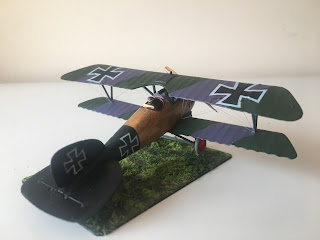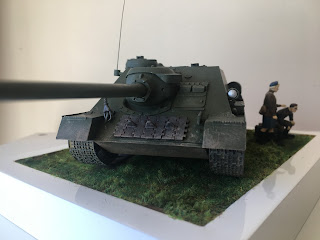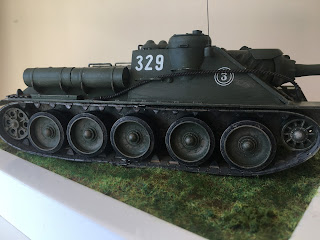Tuesday, November 28, 2017
SPAD XIII and Charles Nungesser
Charles Eugène Jules Marie Nungesser (1892-1927), pilot, daredevil, womanizer, party animal, and the third ranking French ace after Fonck and Guynemer with in all 43 victories. His many exploits won't be listed here, but suffice to say that Nungesser flew a Nieuport for most of the war until August of 1918, when he finally upgraded to a modified SPAD XIII. The modifications included an early gun camera on the top wing and a smaller wind screen, both of which can be found on the model below. By the way, the model is an old SPAD kit re-boxed by Italieri, with all the quirks of the 1960s, I am also quite certain that the scale may be a bit smaller than 1/72, perhaps 1/75 or 1/76. The engine louvres were also removed, as per photographs of Nungesser's SPAD. Also, the pilot's head was repositioned to make the figure look a bit more lively. Painting was done with Vallejo acrylics, and the plane was finally rigged and mounted on a piece of plastic card. The decals came from the spare box, since there's no shortage of aircraft with somewhat morbid Nungesser's personal markings, the black heart with the elements of a funeral inside the heart, a memento mori that contrasted rather well against the extravagant lifestyle of the ace.
Friday, November 24, 2017
Albatros D.III of Leutnant Karl Emil Schäfer
This Revell kit is from 1965, and not a reissue. The parts are crisp and molded , and to my surprise, the decals were in remarkable shape. The kit has some shape issues, especially the sides of the fuselage, which are supposed to be flat. The struts are also way too thick, and the radiator on the top wing is a crude representation. However, I am not going to address these issues, since this is a bit of a nostalgia/fun build, as my models often are. The instructions did not include any painting instructions, so I assume that the builder is supposed to follow the illustration on the box, which would indicate that we're dealing with Manfred von Richthofen - and an airship.
However, this seemed a bit dull, especially since I finished a Richthofen Fokker Triplane less than a year ago. So, after some research, I came to the conclusion that this particular Albatros would be painted as the mount of Leutnant Karl Schäfer, one of the aces of "Bloody April" 1917 that flew for Jasta 11.
After recuperation, Schäfer requested flying duty, and he was transferred to the Eastern Front and Kampfgeschwader 2 in July 1916. Eventually he was transferred to the Western Front and Kampfstaffel 11 of KG2. He gained his first victory flying for this unit, and when he heard of Manfred von Richthofen assembling select combat aviators (Kanone) in Jasta 11, Schäfer impudiently telegraphed von Richthofen and asked to join: "Can you use me?" Richthofen replied, "You have already been requested."
Schäfer joined Jasta 11 on February 21, 1917, and he succeeded in shooting down 21 aircraft, most during "Bloody April" of 1917. He was known affectionately known as Karlchen and apparently became the prankster of Jasta 11. He managed to write an autobiography during his short career, Vom Jaeger zum Flieger, which contains many of his exploits in the air and on the ground. He was awarded the Pour le Merite and several other decorations while serving with Jasta 11.
On April 26, Schäfer was given command of Jasta 28, and he added another nine victories, bringin his total to 30. On June 5, 1917, Schäfer was shot down and killed when his plane probably broke apart in mid-air following combat with Lieutenants Harold Satchell and Thomas Lewis of No. 20 Squadron, RFC, flying an F.E.2d. Schäfer is today commemorated in name of the Bundeswehr barracks at Achum airport, as well as a street in Krefeld and a plaque by the house where Schäfer was born on Uerdinger Straße 231.
However, this seemed a bit dull, especially since I finished a Richthofen Fokker Triplane less than a year ago
http://wp.scn.ru/en/ww1/f/415/59/4
Leutnant Karl Emil Schäfer
The build is pretty straightforward. The pilot and seat fits on pegs, and there's no other interior. The overall fit is good, with some minimal sanding required. Most of the painting was done before attaching the top wing, and Vallejo colors were used. The wood grain was simulated by painting the fuselage tan and dry-brushing long streaks of red brown and burn umber, and then the decals were applied. I did have to omit the lettering below the cockpit, since I didn't have any decent decals for that. Rigging was done with stretched sprue, and finally the model was varnished with dull and gloss coats, depending on if the surface was supposed to be varnished wood, linen or painted wood.
Leutnant Karl Schäfer was one of the Grosskanone of "Bloody April" 1917, although he had quite a short career as an ace. He was born in Krefeld in 1891, and he joined the Jäger Regiment zu Pferd Nr. 10 of the Prussian Army for his obligatory national service before the war, and when the war broke out. Schäfer was an engineering student in Paris, speaking both German and French and being a good draughtsman. He returned to Germany when war broke out, and was assigned to the Reserve Jäger Bataillon 7. Schäfer was promoted to Vizefeldwebel and decorated with the Iron Cross, Second Class in September 1914 before being wounded and hospitalized for six months.
After recuperation, Schäfer requested flying duty, and he was transferred to the Eastern Front and Kampfgeschwader 2 in July 1916. Eventually he was transferred to the Western Front and Kampfstaffel 11 of KG2. He gained his first victory flying for this unit, and when he heard of Manfred von Richthofen assembling select combat aviators (Kanone) in Jasta 11, Schäfer impudiently telegraphed von Richthofen and asked to join: "Can you use me?" Richthofen replied, "You have already been requested."
Schäfer joined Jasta 11 on February 21, 1917, and he succeeded in shooting down 21 aircraft, most during "Bloody April" of 1917. He was known affectionately known as Karlchen and apparently became the prankster of Jasta 11. He managed to write an autobiography during his short career, Vom Jaeger zum Flieger, which contains many of his exploits in the air and on the ground. He was awarded the Pour le Merite and several other decorations while serving with Jasta 11.
On April 26, Schäfer was given command of Jasta 28, and he added another nine victories, bringin his total to 30. On June 5, 1917, Schäfer was shot down and killed when his plane probably broke apart in mid-air following combat with Lieutenants Harold Satchell and Thomas Lewis of No. 20 Squadron, RFC, flying an F.E.2d. Schäfer is today commemorated in name of the Bundeswehr barracks at Achum airport, as well as a street in Krefeld and a plaque by the house where Schäfer was born on Uerdinger Straße 231.
Some links:
https://modelingmadness.com/review/w1/ger/fosd3.htm
http://wwi-cookup.com/albatros/diii/kitreview_earlyalb.html
| No. | Date/time | Unit | Aircraft | Foe | Location |
|---|---|---|---|---|---|
| 1 | 22 January 1917 | Kasta 11 | Albatros D.II | Caudron | West of Pont-à-Mousson |
| 2 | 4 March 1917 @ 1150 | Jasta 11 | Albatros D.III | Sopwith 1½ Strutter (A1109) | South-west of Haisnes |
| u/c | 4 March 1917 | Jasta 11 | D.H.2 or F.E.8 | Near Lens | |
| u/c | 4 March 1917 | Jasta 11 | D.H.2 or F.E.8 | Near Béthune | |
| 3 | 6 March 1917 @ 1145 | Jasta 11 | Sopwith 1½ Strutter (A978) | Lens | |
| 4 | 6 March 1917 @ 1155 | Jasta 11 | Sopwith 1½ Strutter | Lens | |
| 5 | 9 March 1917 @ 1120 | Jasta 11 | F.E.8 (6397) | Faschoda | |
| 6 | 9 March 1917 @ 1122 | Jasta 11 | F.E.8 (4874) | Pont-à-Vendin | |
| 7 | 11 March 1917 @ 1120 | Jasta 11 | B.E.2c (6232) | Loosbogen | |
| 8 | 24 March 1917 @ 0900 | Jasta 11 | Sopwith 1½ Strutter | Anzin, near Arras | |
| 9 | 3 April 1917 @ 1620 | Jasta 11 | F.E.2d (6371) | South of Lens | |
| 10 | 6 April 1917 @ 1020 | Jasta 11 | B.E.2 | Givenchy | |
| 11 | 6 April 1917 @ 1037 | Jasta 11 | B.E.2 | West of Vimy | |
| 12 | 7 April 1917 @ 1745 | Jasta 11 | Nieuport 23 | Mecatal | |
| 13 | 8 April 1917 @ 1440 | Jasta 11 | D.H.4 | Épinoy | |
| 14 | 9 April 1917 @ 1900 | Jasta 11 | B.E.2d (5742) | Aise Roulette | |
| 15 | 11 April 1917 @ 0910 | Jasta 11 | Bristol F.2A (A3318) | Fampoux | |
| 16 | 11 April 1917 @ 1250 | Jasta 11 | B.E.2e | Arras | |
| 17 | 13 April 1917 @ 1830 | Jasta 11 | F.E.2b (A6372) | Le Point du Jour | |
| 18 | 14 April 1917 @ 1705 | Jasta 11 | F.E.2b (4877) | Lievin-Eleu | |
| 19 | 14 April 1917 @ 1720 | Jasta 11 | B.E or Bristol F.2a | La Coulette | |
| 20 | 21 April 1917 @ 1745 | Jasta 11 | Nieuport Scout (A6797) | East of Fresnes | |
| 21 | 22 April 1917 @ 2020 | Jasta 11 | F.E.2b | North-west of Moncy-Tilloy | |
| 22 | 25 April 1917 @ 1040 | Jasta 11 | F.E.2b (A837) | Bailleul | |
| 23 | 25 April 1917 @ 2030 | Jasta 11 | Bristol F.2a (A3352) | Bahnhoff Roeux | |
| 24 | 1 May 1917 @ 1240 | Jasta 28 | Farman | Dixmude | |
| 25 | 1 May 1917 @ 1300 | Jasta 28 | Nieuport Scout | East of Poperinghe | |
| 26 | 9 May 1917 @ 1900 | Jasta 28 | Sopwith 1½ Strutter | Warneton | |
| 27 | 18 May 1917 @ 1110 | Jasta 28 | F.E.2d | Hollebeke | |
| 28 | 23 May 1917 @ 1615 | Jasta 28 | F.E.2d | Warenton | |
| 29 | 23 May 1917 @ 1845 | Jasta 28 | Sopwith Pup | Wytschaetebogen | |
| 30 | 4 June 1917 @ 1410 | Jasta 28 | D.H.4 (A7420) | Moorslede |
Labels:
1/72,
Albatros,
Bloody April,
Jasta 11,
Karl Schäfer,
No. 20 Squadron,
revell,
Satchel,
von Richthofen
Thursday, November 2, 2017
Zvezda 1/35 SU-100
Zvezda kits are quite inexpensive in Latvia, and despite actually being a SU-100M, horrible, horrible tracks, and a very difficult hull fit, I couldn't resist sinking some time into this kit. The dimensions are accurate, though, although the welding seams tend to be a bit more pronounced on real vehicles.
The build started off with painting most of the parts Vallejo Olive Green (brush only, as usual( and then I assembled the wheels. Some white glue was slathered on the lower parts of the hull to simulate mud, and then the upper hull was added. Some plastic strip had to be added to cover a gap between the hull halves in lower front, and this was subsequently sanded down. The tracks required a stapler to connect, and they do not at all conform to how real SU-100 tracks weigh down on the wheels, but I had to work with what was in the box. I was simply too impatient to order replacement tracks.
A picture frame was used as a base for a small diorama, and I wanted to create a bit of a kitschy scene with a female nurse from an ICM kit comforting a heroic but shaky tank commander after the end of the war in Europe.
You can see an unboxing of the kit here: https://www.youtube.com/watch?v=Sx4ATm-I-eM
The build started off with painting most of the parts Vallejo Olive Green (brush only, as usual( and then I assembled the wheels. Some white glue was slathered on the lower parts of the hull to simulate mud, and then the upper hull was added. Some plastic strip had to be added to cover a gap between the hull halves in lower front, and this was subsequently sanded down. The tracks required a stapler to connect, and they do not at all conform to how real SU-100 tracks weigh down on the wheels, but I had to work with what was in the box. I was simply too impatient to order replacement tracks.
A picture frame was used as a base for a small diorama, and I wanted to create a bit of a kitschy scene with a female nurse from an ICM kit comforting a heroic but shaky tank commander after the end of the war in Europe.
You can see an unboxing of the kit here: https://www.youtube.com/watch?v=Sx4ATm-I-eM
Subscribe to:
Posts (Atom)















































































